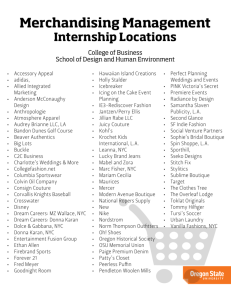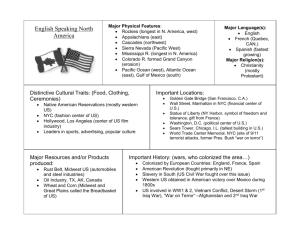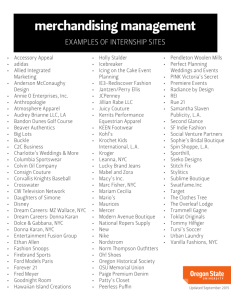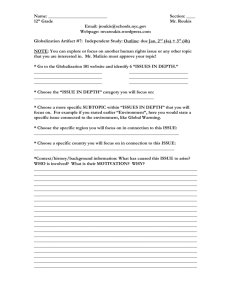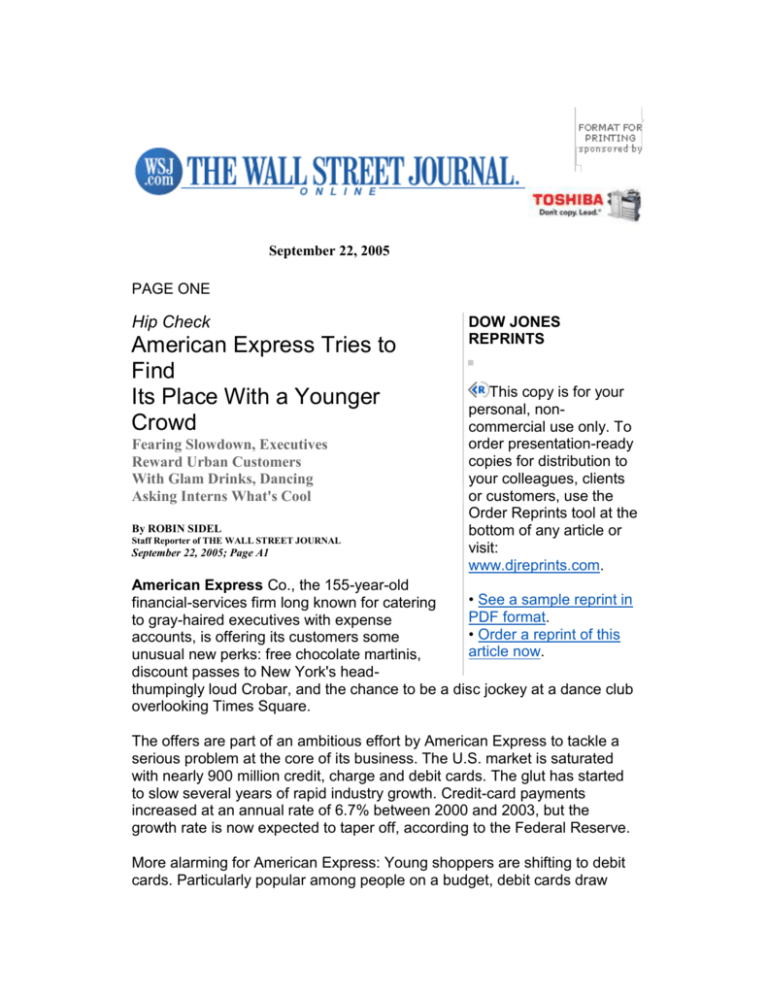
September 22, 2005
PAGE ONE
Hip Check
American Express Tries to
Find
Its Place With a Younger
Crowd
Fearing Slowdown, Executives
Reward Urban Customers
With Glam Drinks, Dancing
Asking Interns What's Cool
By ROBIN SIDEL
Staff Reporter of THE WALL STREET JOURNAL
September 22, 2005; Page A1
DOW JONES
REPRINTS
This copy is for your
personal, noncommercial use only. To
order presentation-ready
copies for distribution to
your colleagues, clients
or customers, use the
Order Reprints tool at the
bottom of any article or
visit:
www.djreprints.com.
American Express Co., the 155-year-old
• See a sample reprint in
financial-services firm long known for catering
PDF format.
to gray-haired executives with expense
• Order a reprint of this
accounts, is offering its customers some
article now.
unusual new perks: free chocolate martinis,
discount passes to New York's headthumpingly loud Crobar, and the chance to be a disc jockey at a dance club
overlooking Times Square.
The offers are part of an ambitious effort by American Express to tackle a
serious problem at the core of its business. The U.S. market is saturated
with nearly 900 million credit, charge and debit cards. The glut has started
to slow several years of rapid industry growth. Credit-card payments
increased at an annual rate of 6.7% between 2000 and 2003, but the
growth rate is now expected to taper off, according to the Federal Reserve.
More alarming for American Express: Young shoppers are shifting to debit
cards. Particularly popular among people on a budget, debit cards draw
directly from a person's bank account,
with no annual fees or monthly balances.
Debit-card charges now represent 60% of
transactions processed by Visa USA Inc.
But American Express has never offered
a debit card, and executives say it
doesn't plan to.
Even its venerable gold and platinum
charge cards are under assault. Visa and
MasterCard International Inc. are both
promoting credit cards with premium
perks like concierge services that help
customers buy hard-to-get tickets to
concerts and shows. Some Wall Street
analysts think American Express may
have to lower the fees it charges
merchants for accepting its cards. Those
fees, which average about 2.54% of each
transaction, have long been the highest in the card industry. Rates set by
Visa and MasterCard averaged 1.78% last year, according to the Nilson
Report, a publication that tracks the industry.
So now American Express is on a high-stakes hunt for young customers,
forcing the company to learn the byways of an unfamiliar new marketplace.
At the center of its quest is a new series of no-fee credit cards for urbanites
who are single, age 25 to 35, dine out often, like to drink and aspire to be
hip. In ads, American Express dubs this "the über-glam lifestyle you'll easily
become accustomed to." Last year it launched the first city card, dubbed
"In:NYC," and aimed at New Yorkers. Earlier this week it followed with
"In:Chicago," and "In:LA" is coming out later this year.
To develop the cards, American Express's executives have been scouring
city hotspots trying to divine the tastes of the often fickle urban crowd. They
grilled company interns about what restaurants and trends were cool, and
found themselves soliciting customers well after midnight on Manhattan's
streets.
The result is a card promising "access" to a lifestyle American Express
hopes is desirable. Instead of earning golf clubs or frequent-flier miles,
points accumulated on the In:NYC card can be redeemed for a private
booth at Underbar, a candle-lit lounge below Union Square's W Hotel, or to
get discounts at Suba, a tapas restaurant where diners sit surrounded by a
pool of rippling water.
The push for new customers comes at a critical time for American Express.
The company has posted 14 consecutive quarters of double-digit earnings
growth, and at $57 its shares are trading at their highest point in nearly five
years. In 2004, American Express earned $3.4 billion, and Chief Executive
Kenneth Chenault has set long-term goals for 12% to 15% earnings pershare growth. "I happen to have a lot of confidence that our growth in
payments is sustainable," Mr. Chenault told investors during a meeting last
month.
American Express has thrived so far by driving up spending on its cards.
After widening its network of merchants, the company has successfully
encouraged its cardholders to charge more everyday purchases, like
gasoline and groceries, on its cards. Such daily purchases now account for
more than 60% of spending on its cards, up from 35% in 1990.
Company executives are also looking to expand American Express's reach
in new areas. American Express has started processing payments for a
general consumer credit card being issued by MBNA Corp., and it expects
to field a similar card with Citigroup Inc. next year. American Express has
even rolled out a technology in some drugstores that lets consumers save
time shopping by simply waving their cards in front of an electronic reader.
The In:NYC card is the most visible example of American Express's
strategy to attract new business. Don Chapman, the company's head of
business development, says he and two colleagues first came up with the
idea for a New York card in 2002 during a two-week brainstorming session
at American Express's lower Manhattan headquarters.
Mr. Chapman's team wanted to capitalize on the popularity of lifestyles
depicted in television shows such as "Sex and the City" and "Friends."
Company data showed these young adults were less likely to already have
an American Express card. Market data also suggests they spend heavily at
businesses that accept cards. Residents of Manhattan between the ages of
25 and 34 are 36% more likely than people of the same age elsewhere in
the country to go to bars, nightclubs or out dancing, according to Simmons
Market Research Bureau, a unit of Experian Inc.
"They go out all the time, they don't have big kitchens, they like being social
and their apartments are just a place where they sleep," Mr. Chapman says.
Reaching Out for Help
Mr. Chapman, a 41-year-old father of two and a Led Zeppelin fan, realized
early on that American Express would need help courting customers as
much as a generation younger than its typical cardholders. The company
organized focus groups and Mr. Chapman began bouncing ideas off
American Express's newer staff members and interns. "I'd pick out the
youngest, hippest person in the office and ask their opinion," he says.
One idea that played badly with the younger set: emblazoning the card with
a New York landmark. Destinations like the Statue of Liberty seemed
touristy, not fashionable. Pictures of neighborhoods, park benches and
pigeons also fell flat. American Express's internal art department eventually
designed a sleek black card with the letters "In:NYC" printed on a window of
clear plastic.
Young New Yorkers also told American Express they coveted access to
social opportunities viewed as off-limits, such as invitations to an exclusive
party or sitting in the VIP area at popular nightclubs.
Once the card's basic idea was established, Mr. Chapman handed the
project over to a group of about a dozen American Express employees,
including E-Bai Koo, a 33-year-old executive put in charge of signing up
card customers. A native New Yorker who attended the exclusive Dalton
School and likes Ferragamo shoes, Mr. Koo fit squarely in the card's target
market.
Mr. Koo says he began scouting out popular Manhattan neighborhoods like
the meat-packing district, a formerly gritty zone alongside the Hudson River
that's been invaded by bistros and wine bars. A buddy from Dalton
suggested letting cardholders redeem rewards more quickly by combining
points with friends, an idea American Express adopted.
Cyndi Somma, American Express's director of strategic alliances, also
started boning up on youth culture. A mother of two who lives in New
Jersey, she says American Express picked carefully which businesses
could participate in the card's rewards program. One merchant tapped early
on was Ricky's, a New York chain that sells novelty items like soybean
candles, feather boas and elaborate costumes that draw throngs of
shoppers on Halloween.
After Ms. Somma's team assembled a slate of potential partners, they
submitted it to Al Kelly, who runs the company's U.S. consumer business.
Mr. Kelly, 46, recalls recognizing the first restaurant on the list. If he was
familiar with it, he told the group, it wasn't hip enough. American Express
declined to identify the restaurant citing its good relationship with
merchants.
The company decided against celebrity endorsements, which it has used to
market other cards. It also pared back on mailings, noting research that
shows young people rarely pay attention to regular mail. "We have to talk to
these prospects differently," Mr. Koo says.
Instead, American Express has peppered the city with playful come-ons. A
cartoon-like mural on a Greenwich Village building touts the card's rewards
program. Advertisements appearing in subway cars poke fun at urban
living. One features two green olives on a toothpick is accompanied by the
line, "veggies, in:nyc."
After the card's launch last September, company executives have kept
close tabs on their audience. At a marketing event this summer at a
ballroom in SoHo, Ms. Somma took mental notes on hundreds of young
women, many of them wearing halters, tight jeans and sparkly belts, who
had come to check out designer fashions and get free makeovers.
Ordering a 'Fashionista'
The event, organized by an arts group, GenArt, was co-sponsored by
American Express. The company maintained an understated presence. It
offered a "fashionista" cocktail (vodka with cranberry, pineapple and orange
juice) and projected a faint image of the In:NYC logo on a wall. Ms. Somma,
outfitted in loafers, a string of pearls and a backpack, says staying low-key
is important. "We have to show them that we know them," she says.
Meanwhile, Mr. Koo's team has been chasing prospects through an
agreement with Clubplanet, an online nightclub guide. Shortly after midnight
on a recent Saturday morning, Renee Farley and two friends waited in a
crowd of more than 100 people to get into Crobar, a massive nightclub in
Manhattan's Chelsea neighborhood. When the 27-year-old elementary
school teacher from New Jersey overheard a Clubplanet representative
pitching In:NYC, she quickly agreed to apply for the card.
Escorted past the velvet ropes to a table where she filled out American
Express's paperwork, Ms. Farley was grateful for the special treatment.
"This is awesome. There is at least an hour wait to get in," she said. Ms.
Farley, who has only one other credit card, says she got her In:NYC card in
the mail a few weeks later, but still hasn't used it.
Tien Mao, a 27-year-old city native, also says his card is collecting dust. Mr.
Mao, who works in the accounting department of a Brooklyn construction
company, says he signed up for In:NYC after seeing advertisements for it
on the Gothamist, a blog where he moonlights as an editor.
After paying off a $600 balance that he transferred to the card, Mr. Mao
hasn't purchased anything with it. Instead, he favors a Visa card that gives
him a 1% cash refund on every purchase. "I'm not a huge club guy and I
don't blow $100 on a bottle of wine at a fancy restaurant so I'd rather have
the cash than their rewards," says Mr. Mao.
New Business
Some city merchants say In:NYC's rewards program is starting to bring in
new business. Rusti Wolintz, general manager of Amuse, a restaurant that
serves appetizer-sized dishes in Manhattan's Chelsea neighborhood, says
about 20 cardholders have redeemed points to get discounts at the
restaurant. She thinks the card is bringing in people to "check out our
restaurant for the first time."
A year after the card's launch, American Express won't say how many
In:NYC cards it has issued. The company also declines to reveal how much
the average cardholder is charging each month, typically the most important
metric of success. Company executives do say that 90% of people who
have signed up for In:NYC have never had any type of American Express
card before. They also say more than half of the cardholders are under 35.
That is the youngest customer base for any American Express credit or
charge card.
Now that American Express is moving ahead with similar cards in Chicago
and Los Angeles, executives say they have found some regional
differences in what matters to young people. The Chicago card will have a
sharper focus on neighborhood restaurants and will feature more sportsrelated programs. The company's research has also shown that young
women in Chicago prefer beer over cosmopolitans.
Write to Robin Sidel at robin.sidel@wsj.com1
URL for this article:
http://online.wsj.com/article/0,,SB112735069286048131,00.html
Hyperlinks in this Article:
(1) mailto:robin.sidel@wsj.com
Copyright 2005 Dow Jones & Company, Inc. All Rights Reserved
This copy is for your personal, non-commercial use only. Distribution and use of this
material are governed by our Subscriber Agreement and by copyright law. For nonpersonal use or to order multiple copies, please contact Dow Jones Reprints at 1-800843-0008 or visit www.djreprints.com.

